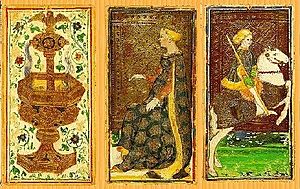Visconti-Sforza Tarot facts for kids
The Visconti-Sforza Tarot is a name for several old, incomplete sets of playing cards from the mid-1400s. These cards are now found in museums, libraries, and private collections worldwide. No full deck has survived. Some collections have only a few face cards, while others have just one card.
These are the oldest tarot cards still existing today. Back then, they were called Trionfi, meaning "triumphs" or trump cards. People used them for everyday games. Important rulers of Milan, Filippo Maria Visconti and his son-in-law Francesco Sforza, ordered these cards to be made. These early decks greatly influenced how modern tarot cards look, are numbered, and are understood.
Contents
Discovering the Old Tarot Cards
The surviving cards are very important for history. They show beautiful and detailed designs. Artists often used valuable materials to make them. Many cards show members of the Visconti and Sforza families. They are dressed in clothes from that time and shown in their homes.
Because of this, the cards give us a peek into the lives of noble families in Renaissance Milan. The Visconti family had lived in Milan since the 1200s.
Below, we will look closer at the three most famous sets of these cards.
The Pierpont Morgan Bergamo Deck
This deck is also known as the Colleoni-Baglioni or Francesco Sforza deck. It was likely made around 1451. It originally had 78 cards. Today, 74 cards remain: 20 trump cards, 15 face cards, and 39 pip cards (numbered cards).
The Morgan Library & Museum in New York City has 35 of these cards. The Accademia Carrara in Italy has 26. The last 13 cards are owned by the Colleoni family in Bergamo. The trump and face cards have a shiny gold background. The pip cards are cream-colored with a design of flowers and vines. The "Devil" and "Tower" trump cards are missing from this set. Modern copies of this deck often include recreated versions of these missing cards.
Let's look at the suits:
- The figures on the bastoni (staffs) cards wear silver clothes. They carry a long staff. Most staffs have a large pot at each end, except for the King's staff.
- The figures on the cups cards wear gold clothes. Their clothes are decorated with a sun and sunbeams. Each figure holds a large cup, which is common for this suit.
- The spades (swords) cards show figures wearing full armor. They carry a large sword.
- Interestingly, the characters on the denari (coins) cards wear clothes decorated with blue ribbons wrapped around circular suns.
The Cary-Yale Deck
This deck is named after the Cary Collection of Playing Cards. This collection became part of the Yale University Library in 1967. It is also known as the Visconti di Modrone set. Experts believe it was made around 1466. However, some scholars think it might be the oldest set. They suggest Filippo Maria Visconti might have ordered it at the very start of the project.
67 cards from this deck have survived. These include 11 trump cards, 17 face cards, and 39 pip cards. Some people believe that this deck originally had 86 cards.
A scholar named Giordano Berti suggested in 2007 that this deck was made between 1442 and 1447. He noticed that the denari (coin) cards show both sides of a gold coin. This coin was made by F. M. Visconti in 1442 and stopped being used when he died in 1447.
The Cary-Yale deck is special because it is the only old Western deck with six types of face cards. Besides the usual King, Queen, Knight, and Jack, it also has a "Damsel" and a "Lady on Horse." You can tell their rank by their position: standing, riding a horse, or sitting on a throne. The trump cards in this deck also show three important ideas: Faith, Hope, and Charity. These only appear in this deck and in Minchiate decks. All trump cards have a gold background. The pip cards have a silver background.
The Brera-Brambilla Deck
This set is named after Giovanni Brambilla. He bought the cards in Venice in 1900. Since 1971, the deck has been at the Brera Gallery in Milan. It seems that Francesco Sforza ordered these cards from Bonifacio Bembo in 1463.
Today, this deck has 48 cards. Only two trump cards remain: the Emperor and the Wheel of Fortune. All face cards in this set have a gold background. The pip cards have a silver background.
The seven remaining face cards are: the Knight and Jack of cups; the Knight and Jack of denari; and the Knight, Jack, and Queen of bastoni. Almost all the pip cards have survived. Only the four of denari is missing from this set.
See also
 In Spanish: Baraja de tarot Visconti-Sforza para niños
In Spanish: Baraja de tarot Visconti-Sforza para niños

















